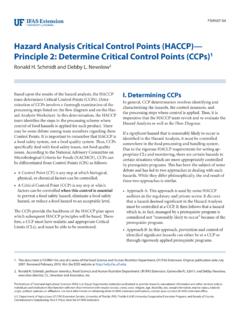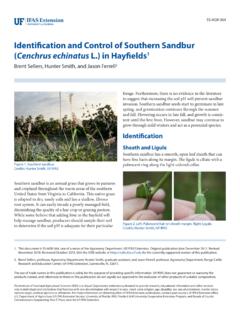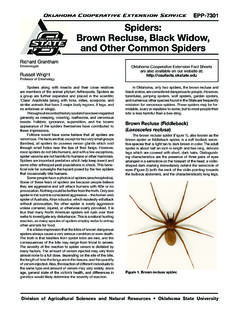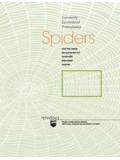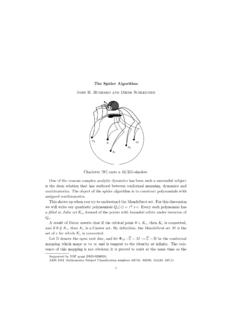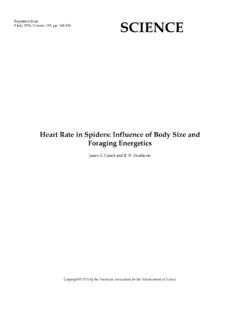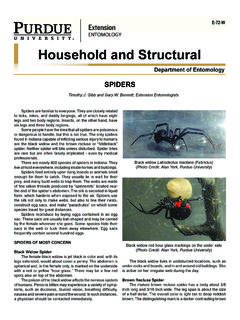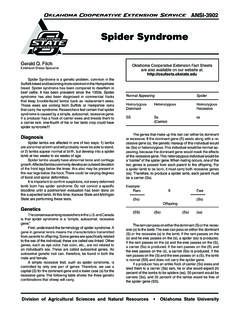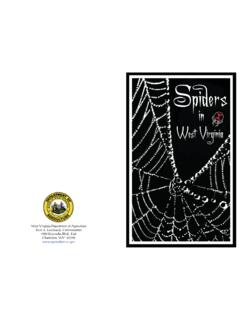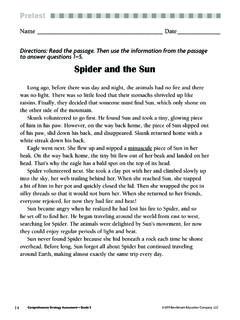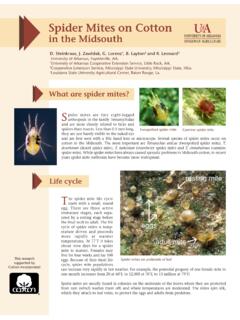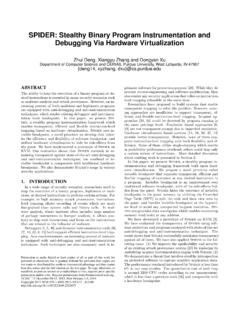Transcription of Spiders - edis.ifas.ufl.edu
1 ENY201. Spiders1. P. G. Koehler and C. A. Andrews2. conditions within human dwellings that they can no longer survive outside. In their natural environment (including human dwellings) Spiders are important arthropod predators and serve a vital function in controlling insect populations. Due to Spiders ' reclusive habits, most people are unaware of how many Spiders actually exist in a given environment at any time. A single acre of grassy field, for example, can contain up to two million individual Spiders . Although all spider species possess venom-injecting fangs, only a tiny minority are able to pierce human skin and inject venom into the tissue. Among this minority, only a few pose any threat to human health. The brown recluse and the widow Spiders are two well-known and highly venomous examples. Biology and Description Spiders are arachnids, related to mites, ticks, and scorpions, which differ from insects in their body morphology in three This fact sheet is excerpted from SP486: Pests in and around the important ways: Southern Home, which is available from the UF/IFAS Extension Bookstore.
2 Spiders have only two body regions (cephalothorax and abdomen) rather than three. There are a little over 40,000 species of spider in the world, Spiders have eight walking limbs rather than six. about 1,200 of which may be found in the United States. Spiders never develop wings, unlike many insects. They live everywhere, even inside homes and buildings. In fact, some spider species have become so adapted to 1. This document is ENY201, one of a series of the Department of Entomology and Nematology, UF/IFAS Extension. Original publication date January 1994. Revised August 2003, July 2011, and October 2013. Reviewed February 2017. Visit the edis website at 2. P. G. Koehler, professor, Extension entomologist; and C. A. Andrews, Department of Entomology and Nematology; UF/IFAS Extension, Gainesville, FL. 32611. The use of trade names in this publication is solely for the purpose of providing specific information. UF/IFAS does not guarantee or warranty the products named, and references to them in this publication do not signify our approval to the exclusion of other products of suitable composition.
3 Use pesticides safely. Read and follow directions on the manufacturer's label. The Institute of Food and Agricultural Sciences (IFAS) is an Equal Opportunity Institution authorized to provide research, educational information and other services only to individuals and institutions that function with non-discrimination with respect to race, creed, color, religion, age, disability, sex, sexual orientation, marital status, national origin, political opinions or affiliations. For more information on obtaining other UF/IFAS Extension publications, contact your county's UF/IFAS Extension office. Department of Agriculture, UF/IFAS Extension Service, University of Florida, IFAS, Florida A & M University Cooperative Extension Program, and Boards of County Commissioners Cooperating. Nick T. Place, dean for UF/IFAS Extension. Spiders are predators, feeding primarily on insects and other arthropods. Although the exact details of the feeding strategies for Spiders vary, all Spiders predigest their prey by injecting or covering the prey item with digestive fluids, after which they consume the liquefied meal.
4 Spiders can survive for long periods of time without feeding. Some Spiders have been kept alive for over two years without feeding. Because Spiders feed entirely on living insects or other animals, they are highly adapted to capture and subdue living prey. Some, such as jumping Spiders or wolf Spiders (Figure 2), actively search for or stalk their prey. Others, such as the trap-door Spiders , hide and wait for hapless arthropods to pass too closely. Perhaps the best known Figure 3. A common house spider and egg sac. Spiders are called orb weavers, who build ornate webs that trap flying insects. Almost all Spiders are harmless to humans, and most species do not attempt to bite unless they are provoked. Spiders usually remain hidden and do not seek out and bite humans. Most Spiders cannot penetrate the skin of a human with their fangs. All Spiders produce venom, but only a few can pierce human skin, and even fewer are considered dangerous to humans.
5 Spiders are of interest since some invade homes, others are considered venomous, and some larger species are raised as pets. House Spiders Several species of spider enter houses and become nuisances to the homeowner. Many people simply dislike Figure 2. Common wolf spider (actual size 1 inch). Spiders and cannot tolerate their presence. When numer- Most web-spinning Spiders build and abandon several ous, Spiders are annoying because they construct webs, webs per year. The webs are produced by glands on the which collect dust and other detritus, resulting in cobwebs. spider 's abdomen. The silk is a liquid protein that is shaped However, most Spiders are considered beneficial because into various configurations by the spider 's appendages as they feed on insect pests and other Spiders . it is excreted. Silk is used to construct webs, safety lines, Newly hatched Spiders are tiny and easily enter homes shelters, and egg sacs. A special type of silk is sometimes through screens or around loose fitting doors and windows.
6 Used as a parachute by spiderlings for dispersal or adults to Careful screening will keep larger Spiders out of homes. If travel long distances. insects that serve as spider prey are not plentiful in a home, Spiders reproduce by laying eggs in a silken egg sac (Figure Spiders are less likely to infest a home. 3). The egg sac is either carried around by the female or hidden in the web. Egg sacs of large Spiders may contain Non-chemical Control of Spiders several hundred eggs. The eggs hatch in about two to three Nonchemical control of Spiders is usually quite effective in weeks after they are deposited. Most young Spiders mature reducing spider populations. Outside lights should not be to adults in about one year. Male and female Spiders live left on at night. Large numbers of flying insects attracted separately and only come together to mate. Males are to lights cause Spiders to be numerous around garages and usually smaller and color-marked differently from females.
7 Under eaves. Trash, lumber piles, bricks, weeds, and outside structures are good breeding places for Spiders and should Spiders 2. be cleaned up regularly. Inside the home, spider webs hourglass on the underside of the abdomen. The red widow should be brushed down. The egg sacs should be destroyed spider has a reddish orange head, thorax, and legs, and a to prevent hundreds of young Spiders from emerging. A black abdomen. The abdomen may have a dorsal row of red vacuum cleaner fitted with appropriate attachments may spots with a yellow border. The red widow lacks a complete be used to clean walls, and the collected debris should be hourglass under the abdomen but may have one or two destroyed or removed from the house. red spots. The brown widow spider varies in color from gray to light brown or black. The abdomen has variable Chemical Control of Spiders markings of black, white, red and yellow. On the underside of the abdomen it has an orange or yellowish-red hourglass Chemical control of Spiders outdoors is difficult because marking.
8 Web-spinning Spiders do not tend to contact treated sur- faces. Space sprays containing pyrethrins or pyrethroids are effective in killing Spiders , but have little residual activity. These sprays may be applied when Spiders are noticed. When spraying enclosed areas, care should be taken so Spiders agitated by the spray do not drop onto the person doing the spraying. Repeat the treatment in four weeks to kill young Spiders that hatch from egg sacs. Dust formulations can be used in crawlspaces, attics, and utility areas to provide long-term protection. The insecti- cidal dusts tend to cling to the spider webs for long periods of time. When Spiders chew their webs to recycle the silk they consume the toxicant and die. Figure 4. a) Southern lack widow. b) Northern black widow. c) Red widow. d) Brown widow. Venomous Spiders It is important to save any biting spider so it can be identi- The life cycles of the widow Spiders are all similar.
9 The fied later. Without a specimen for positive identification, female lays approximately 250 eggs in an egg sac, which spider bites are often improperly treated, and in many cases is about 1/2 to 5/8 inch in diameter. Female widows remain other medical conditions are mistaken for spider bites. with the egg sac and guard it aggressively from potential Most spider bites are not dangerous, but medical care and predators. The eggs hatch in 20 days and the young Spiders advice should be sought in any case of a suspected spider (called post-embryos) remain in the egg sac from about bite. four days to one month. The young Spiders then molt to the second stage and begin feeding. As the young Spiders grow, Widow Spiders they construct loosely woven webs and capture progres- sively larger prey. Male Spiders molt three to six times Four species of widow Spiders occur: the southern black before maturing. The females molt six to eight times and widow, the northern black widow, the red widow, and the occasionally eat the males after mating.
10 In Florida, all the brown widow (Figure 4). All these species are rather large widows except the northern black widow breed year-round. Spiders , about 11/2 inches long with the legs extended. To catch prey, widow Spiders weave a strong web of irregular The southern black widow is usually found outdoors in strands. The web is often found in rock formations or wood protected places such as in hollows of stumps, discarded piles. Strands of black widow web were used to form the building materials, rodent burrows, storm sewers, and crosshairs of gun sights during World War II due to the under park benches and tables. Around houses, the strength and durability of the silk material. southern black widow is found in garages, storage sheds, crawl spaces under buildings, furniture, ventilators, and The southern black widow and the northern black widow rainspouts. are a shiny jet-black. The southern black widow has a red hourglass marking on the underside of the abdomen The northern black widow is mainly found in forests.





